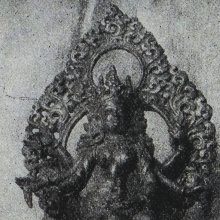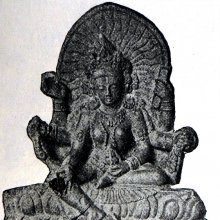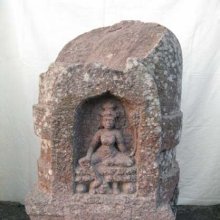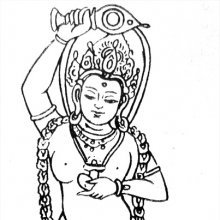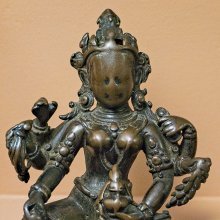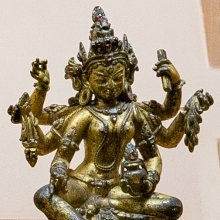Vasudhara, Vasudhārā, Vasudhāra, Vasu-dhara: 17 definitions
Introduction:
Vasudhara means something in Buddhism, Pali, Hinduism, Sanskrit. If you want to know the exact meaning, history, etymology or English translation of this term then check out the descriptions on this page. Add your comment or reference to a book if you want to contribute to this summary article.
Images (photo gallery)
(+11 more images available)
In Hinduism
Purana and Itihasa (epic history)
Source: archive.org: Puranic EncyclopediaVasudhārā (वसुधारा).—A holy place. Those who visit this place could enjoy the fruits of performing horse-sacrifice. If one gives offering to the manes after getting oneself purified by bathing in this holy tīrtha (bath), one will attain the world of Viṣṇu. There is a lake of the Aṣṭavasus (eight Vasus) in this place. By bathing there, one could become the subject of the love and regard of the eight Vasus. (Mahābhārata Vana Parva, Chapter 82, Stanza 63).
Source: archive.org: Shiva Purana - English TranslationVasudharā (वसुधरा) is another name for Alakā, the “capital of Kubera”, as mentioned in the Śivapurāṇa 2.1.18.—“[...] Alakā is the capital of Kubera, the chief of the Yakṣas and Guhyakas. It is also called Prabhā, Vasudharā and Vasusthalī and is fabled to be situated on a peak of the Himālayas, inhabited also by Śiva.
Source: Cologne Digital Sanskrit Dictionaries: The Purana IndexVasudhāra (वसुधार).—A mountain where there are eight temples to the Vasus.*
- * Vāyu-purāṇa 38. 23; 39. 44; 42. 30.
Vasudhārā (वसुधारा) refers to the name of a Tīrtha (pilgrim’s destination) mentioned in the Mahābhārata (cf. ). Note: The Mahābhārata (mentioning Vasudhārā) is a Sanskrit epic poem consisting of 100,000 ślokas (metrical verses) and is over 2000 years old.

The Purana (पुराण, purāṇas) refers to Sanskrit literature preserving ancient India’s vast cultural history, including historical legends, religious ceremonies, various arts and sciences. The eighteen mahapuranas total over 400,000 shlokas (metrical couplets) and date to at least several centuries BCE.
Chandas (prosody, study of Sanskrit metres)
Source: Shodhganga: a concise history of Sanskrit Chanda literatureVasudhārā (वसुधारा) refers to one of the 135 metres (chandas) mentioned by Nañjuṇḍa (1794-1868 C.E.) in his Vṛttaratnāvalī. Nañjuṇḍa was a poet of both Kannada and Sanskrit literature flourished in the court of the famous Kṛṣṇarāja Woḍeyar of Mysore. He introduces the names of these metres (e.g., Vasudhārā) in 20 verses.

Chandas (छन्दस्) refers to Sanskrit prosody and represents one of the six Vedangas (auxiliary disciplines belonging to the study of the Vedas). The science of prosody (chandas-shastra) focusses on the study of the poetic meters such as the commonly known twenty-six metres mentioned by Pingalas.
Kavya (poetry)
Source: Wisdom Library: KathāsaritsāgaraVasudhara (वसुधर) is the name of a porter (bhārika) from Kauśāmbī, according to the Kathāsaritsāgara, chapter 57. Accordingly, as Ratnadatta said to Udayana and Naravāhanadatta: “... there is a poor porter here, of the name of Vasundhara [Vasudhara]; and suddenly he is found of late to be eating, drinking, and bestowing alms. So, out of curiosity, I took him to my house, and gave him food and drink to his heart’s content, and when I had made him drunk, I questioned him..”.
The Kathāsaritsāgara (‘ocean of streams of story’), mentioning Vasudhara, is a famous Sanskrit epic story revolving around prince Naravāhanadatta and his quest to become the emperor of the vidyādharas (celestial beings). The work is said to have been an adaptation of Guṇāḍhya’s Bṛhatkathā consisting of 100,000 verses, which in turn is part of a larger work containing 700,000 verses.

Kavya (काव्य, kavya) refers to Sanskrit poetry, a popular ancient Indian tradition of literature. There have been many Sanskrit poets over the ages, hailing from ancient India and beyond. This topic includes mahakavya, or ‘epic poetry’ and natya, or ‘dramatic poetry’.
In Buddhism
Tibetan Buddhism (Vajrayana or tantric Buddhism)
Source: archive.org: The Indian Buddhist Iconography1) Vasudhārā (वसुधारा) refers to one of the female emanations of Akṣobhya, as mentioned in the 5th-century Sādhanamālā (a collection of sādhana texts that contain detailed instructions for rituals).—Her Colour is yellow; her Mudrā is the varada; her Symbol is ears of corn.—Vasudhārā figures in the pantheon of the Mahāyāna Buddhists asthe consort of Jambhala, the Buddhist god of wealth. Only three sādhanas are devoted to her worship and in one of these only is she said tobear the image of Akṣobhya. The two others assign her to the Dhyāni Buddha Ratnasambhava. It may be noticed, by the way, that Vasudhārā is of a greater antiquity than the Dhyāni Buddhas themselves.
The Dhyāna (meditation instructions) of Vasudhārā described in the Sādhanamālā as follows:—
“The worshipper should conceive himself as the goddess Vasudhārā of golden complexion and decked in all sorts of ornaments. She appears a young girl of twice eight years, exhibits the varada-mudrā in the right hand, carries the ears of corn in the left, and bears the image of Akṣobhya on the crown. In front of the goddess should be conceived Śrīvasundharā, in the right Vasuśrī, in the west Śrīvasumukhī, and in the left Vasumatiśrī. These four goddesses originate from the first syllables of their names, and are identical in form with the principal goddess.”
2) Vasudhārā (वसुधारा) also refers to one of the various emanations of Ratnasambhava.—Her Colour is yellow; her Symbol is ears of corn; she has one face and two arms..—Vasudhārā is the consort of Jambhala and bears the image of either Akṣobhya or Ratnasambhava on her crown. Several Sādhanas in the Sādhanamālā describe her form which is invariably two-armed
The Dhyāna (meditation instructions) of Vasudhārā described in the Sādhanamālā as follows:—
“The worshipper should conceive himself as (Vasudhārā ) who originates from the yellow germ syllable ‘Vaṃ’. She is two-armed, one-faced, of yellow complexion, is in the prime of youth and is decked in all sorts of ornaments and garments. She carries in her left hand the ears of corn on a vessel showering gems, while the right exhibits the varada-mudrā. She is surrounded by many lady friends, rests on the moon over the double lotus, and bears the image of Ratnasambhava on the crown”.
[As none of the sādhanas mentions the āsana, she may be represented in any attitude, standing or sitting... Vasudhārā is sometimes represented as one^ faced and six-armed, and as sitting in the lalita attitude. In the three right hands she exhibits the namaskāra-mudrā, the varada-mudrā and the ears of corn. The first left hand has the book, the second the ears of corn, and the third on the lap carries the vessel containing jewels. Her hair rises upwards in the shape of a flame, she is beautifully decked in ornaments and her expression is truly peaceful.]

Tibetan Buddhism includes schools such as Nyingma, Kadampa, Kagyu and Gelug. Their primary canon of literature is divided in two broad categories: The Kangyur, which consists of Buddha’s words, and the Tengyur, which includes commentaries from various sources. Esotericism and tantra techniques (vajrayāna) are collected indepently.
General definition (in Buddhism)
Source: Cambridge Digital Library: Pañcarakṣā, SaptavāraVasudhārā (वसुधारा) refers to the first of “seven days” (saptavāra) classified as a dhāraṇī according to a 17th-century Sanskrit manuscript from Nepal .—This collection associates each dhāraṇī with a specific day of the week, a tradition going back to at least the sixteenth century in Nepal.
Languages of India and abroad
Sanskrit dictionary
Source: DDSA: The practical Sanskrit-English dictionaryVasudhārā (वसुधारा).—the capital of Kubera. [वसोर्धारा (vasordhārā)
1) a stream of ghee prepared for Vasus; कुड्यलग्नां वसोर्धारां सप्त वारान् घृतेन तु । कारयेत् पञ्च वारान् वा नातिनीचां न चोच्छ्रिताम् (kuḍyalagnāṃ vasordhārāṃ sapta vārān ghṛtena tu | kārayet pañca vārān vā nātinīcāṃ na cocchritām) Chhandogapaddhati.
2) Name of a vessel for pouring ghee into fire; त्वया द्वादशवर्षाणि वसोर्धाराहुतं हविः (tvayā dvādaśavarṣāṇi vasordhārāhutaṃ haviḥ) Mahābhārata (Bombay) 1.223.72.
3) Name of the heavenly Ganges (mandākinī); Mahābhārata (Bombay) 13.8.5.].
Vasudhārā is a Sanskrit compound consisting of the terms vasu and dhārā (धारा). See also (synonyms): vasubhārā.
Source: Cologne Digital Sanskrit Dictionaries: Edgerton Buddhist Hybrid Sanskrit DictionaryVasudhārā (वसुधारा).—name of a goddess(?), possibly a form of Tārā; like T. associated with Sudhana (3), q.v., in Sādhanamālā 46.11; name of a yakṣiṇī (the same?), consort of Jambhala, Sādhanamālā 561.1 etc.; compare next.
Source: Cologne Digital Sanskrit Dictionaries: Shabda-Sagara Sanskrit-English DictionaryVasudhārā (वसुधारा).—f.
(-rā) 1. A female Sakti peculiar to the Jainas. 2. The capital of Kuvera. E. vasu wealth, dhṛ to have, affs. ghañ and ṭāp; some authorities read vasubhārā for Kuvera'S capital.
Source: Cologne Digital Sanskrit Dictionaries: Benfey Sanskrit-English DictionaryVasudhāra (वसुधार).—i. e. vasu-dhṛ + a, adj. Having wealth, [Hitopadeśa] ii. [distich] 102 (cf. Böhtl. Ind. Spr. 2220).
Source: Cologne Digital Sanskrit Dictionaries: Cappeller Sanskrit-English DictionaryVasudhāra (वसुधार).—[adjective] holding treasures.
Source: Cologne Digital Sanskrit Dictionaries: Aufrecht Catalogus CatalogorumVasudhara (वसुधर) as mentioned in Aufrecht’s Catalogus Catalogorum:—poet. [Subhāshitāvali by Vallabhadeva]
Source: Cologne Digital Sanskrit Dictionaries: Monier-Williams Sanskrit-English Dictionary1) Vasudhara (वसुधर):—[=vasu-dhara] [from vasu > vas] m. Name of a poet, [Subhāṣitāvali]
2) Vasudharā (वसुधरा):—[=vasu-dharā] [from vasu-dhara > vasu > vas] f. (with Buddhists) Name of a goddess, [Buddhist literature]
3) Vasudhāra (वसुधार):—[=vasu-dhāra] [from vasu > vas] mfn. holding w° or treasure, [Hitopadeśa]
4) [v.s. ...] m. Name of a mountain, [Mārkaṇḍeya-purāṇa]
5) Vasudhārā (वसुधारा):—[=vasu-dhārā] [from vasu-dhāra > vasu > vas] f. (with Buddhists) Name of a goddess, [Buddhist literature]
6) [v.s. ...] a female Śakti peculiar to the Jainas, [Monier-Williams’ Sanskrit-English Dictionary]
7) [v.s. ...] Name of a river, [Harivaṃśa]
8) [v.s. ...] of the capital of Kubera, [cf. Lexicographers, esp. such as amarasiṃha, halāyudha, hemacandra, etc.]
9) [v.s. ...] a stream of wealth, st° of gifts, [Mahābhārata; Harṣacarita; Hemacandra’s Pariśiṣṭaparvan]
Source: Cologne Digital Sanskrit Dictionaries: Yates Sanskrit-English DictionaryVasudhārā (वसुधारा):—[vasu-dhārā] (rā) 1. f. A female shakti peculiar to the Jainas; the capital of Kuvera.
[Sanskrit to German]
Sanskrit, also spelled संस्कृतम् (saṃskṛtam), is an ancient language of India commonly seen as the grandmother of the Indo-European language family (even English!). Closely allied with Prakrit and Pali, Sanskrit is more exhaustive in both grammar and terms and has the most extensive collection of literature in the world, greatly surpassing its sister-languages Greek and Latin.
See also (Relevant definitions)
Starts with: Vacutarai, Vasudharamaya.
Ends with: Shrivasundhara.
Full-text (+20): Vasudharamaya, Vasusara, Vacutarai, Dhumra, Draviṇa, Kimshukavana, Bilvasthali, Vasusthali, Prabha, Saptavara, Vasundhara, Devi, Vasumatishri, Subhadra, Sudatta, Carendra, Vaishrayana, Vasushri, Shrivasundhara, Shrivasumukhi.
Relevant text
Search found 20 books and stories containing Vasudhara, Vasudhārā, Vasudhāra, Vasu-dhara, Vasu-dhārā, Vasudharā, Vasu-dharā, Vasu-dhāra; (plurals include: Vasudharas, Vasudhārās, Vasudhāras, dharas, dhārās, Vasudharās, dharās, dhāras). You can also click to the full overview containing English textual excerpts. Below are direct links for the most relevant articles:
The Indian Buddhist Iconography (by Benoytosh Bhattachacharyya)
Figure 186-188 - Emanations of Ratnasambhava: Vasudhārā
Figure 176-179 - Emanations of Ratnasambhava: Jambhala
Sripura (Archaeological Survey) (by Bikash Chandra Pradhan)
Scultures of Buddhist Goddesses (4): Vasudhara < [Chapter 3 - Sculptural Programme]
Bronze-icons < [Chapter 3 - Sculptural Programme]
Stupas in Orissa (Study) (by Meenakshi Chauley)
Emanations of Ratnasambhava < [Chapter 5]
Minor Votive Stupas at Ratnagiri < [Chapter 4]
Cidgaganacandrika (study) (by S. Mahalakshmi)
Verse 70 [Pralayāgni] < [Chapter 2 - Second Vimarśa]
Blue Annals (deb-ther sngon-po) (by George N. Roerich)
Chapter 2b - The Lineage of the mdo < [Book 3 - Early translations of Secret Mantra]
The Linga Purana (by J. L. Shastri)
Chapter 50 - The abodes of Devas (bhuvanavinyāsa) < [Section 1 - Uttarabhāga]
